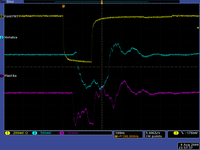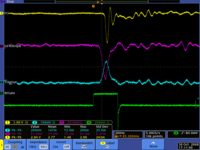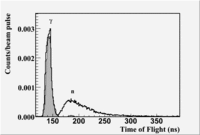Difference between revisions of "TF NEUP 2011"
| Line 6: | Line 6: | ||
=Project Summary= | =Project Summary= | ||
| − | This project seeks to improve the response of a fission chamber by transferring a technology, known as Gas Electron Multiplication, developed in the late 1990s for high energy physics detectors. This technology has demonstrated an improvement in an ionization chamber's response time by at least a factor of 3. The faster detector signal will extend the detectable neutron flux | + | This project seeks to improve the response of a fission chamber by transferring a technology, known as Gas Electron Multiplication, developed in the late 1990s for high energy physics detectors. The device functions as a preamplifier that is immersed in the detectors gas. The preamplifier This technology has demonstrated an improvement in an ionization chamber's response time by at least a factor of 3. The faster detector signal will extend the detectable neutron flux beyond the current signal pile up region. The increased signal amplification improves the detectors ability to measure the location of the incident particle on the entrance to the detector. |
We propose to develop a gaseous detector sensitive to fast (100 keV - 100 MeV) neutrons. Fission chambers are a standard gaseous detector used by the nuclear industry. | We propose to develop a gaseous detector sensitive to fast (100 keV - 100 MeV) neutrons. Fission chambers are a standard gaseous detector used by the nuclear industry. | ||
Revision as of 17:50, 21 October 2011
Technical Work Scope Identifier: FC-3
Project Summary
This project seeks to improve the response of a fission chamber by transferring a technology, known as Gas Electron Multiplication, developed in the late 1990s for high energy physics detectors. The device functions as a preamplifier that is immersed in the detectors gas. The preamplifier This technology has demonstrated an improvement in an ionization chamber's response time by at least a factor of 3. The faster detector signal will extend the detectable neutron flux beyond the current signal pile up region. The increased signal amplification improves the detectors ability to measure the location of the incident particle on the entrance to the detector. We propose to develop a gaseous detector sensitive to fast (100 keV - 100 MeV) neutrons. Fission chambers are a standard gaseous detector used by the nuclear industry.
Importance and relevance of proposed work
The NEUP's 2012 request for pre-applications calls for Program Supporting and Mission Supporting R&D in Fuel Cycle Research and Development, Reactor Concepts Research, Development and Demonstration, and Nuclear Energy Advanced Modeling and Simulation. Previous calls for similar pre-applications have identified a need for the detection of fission multiplicity and measurements of the incident neutron energy spectrum to support the mission goals defined in the Nuclear Energy Research and Development Roadmap. The April 2010 Roadmap report to congress identified the "Obsolete analog instrumentation and control technologies" as one of the major challenges facing the current nuclear power plant fleet. We propose to investigate an upgrade to this instrumentation by transferring an innovation developed for gaseous detectors in the late 1990s. Fission chambers equipped with this technology could have their neutron detection rise time decreased by a factor of 3 ind increase their ability to sustain higher neutron fluxes compared with what is currently deployed in the fleet.
From the RFP
his research topic will also pursue advanced measurement techniques that could
complement the ongoing measurement program. In particular, fission multiplicity and fission neutron
spectrum measurements as a function of incident neutron energy have been identified as important data in
recent sensitivity analyses. Key university research needs for this activity include:
" New and improved detector systems and sensor materials that can be used to increase the
accuracy, reliability, and efficiency of nuclear materials quantification and tracking from the
perspective of the operator or state-level regulator. Such systems could include new neutron
coincidence/anti-coincidence counting, spectroscopic analysis, chemical, calorimetric, or other
non-nuclear methods, as well as any other novel methods with potential MC&A benefits;
Mission Supporting R&D is considered creative, innovative, and transformative (blue-sky), but
must also support the NE mission. Mission-supporting activities that could produce breakthroughs
in nuclear technology are also invited to this solicitation. This includes research in the fields or
disciplines of nuclear science and engineering that are relevant to NE’s mission though may not
fully align with the specific initiatives and programs identified in this solicitation. This includes,
but is not limited to, Nuclear Engineering, Nuclear Physics, Health Physics, Radiochemistry,
Nuclear Materials Science, or Nuclear Chemistry. Examples of topics of interest are new reactor
designs and technologies, advanced nuclear fuels and resource utilization, instrumentation and
control/human factors, radiochemistry, fundamental nuclear science, and quantification of
proliferation risk and creative solutions for the management of used nuclear fuel.
Program supporting research requested by this solicitation is detailed as discreet workscopes in
Appendix A. The information is organized by program area with each specified workscope
providing the basis for a stand-alone R&D pre-application submittal.
Fuel Cycle Research and Development
New and improved detector systems and sensor materials that can be used to increase the
accuracy, reliability, and efficiency of nuclear materials quantification and tracking from the
perspective of the operator or state-level regulator. Such systems could include new neutron
coincidence/anti-coincidence counting, spectroscopic analysis, chemical, calorimetric, or other
non-nuclear methods, as well as any other novel methods with potential MC&A benefits;
Logical pathway to work accomplishments
The first year of effort will focus on the production of pre-amplifiers for ionization chamber. A fissionable material will be added to the ionization chamber in year two followed measurements of the chamber's neutron detection efficiency.
Deliverables and outcomes
Timeline
Budget
| IAC | Task |
Each year
1 grad students ($50k)
2 faculty summer months ($20k)
Beam time: electron experiment which produces isotropic neutrons. Compare neutron rates seen by several know detectors to the rate from the THGEM based detector.
Neutron fluxes in reactors
according to http://www.bnl.gov/bnlweb/history/HFBR_main.asp
a 40 MW reactor at Brookhaven's High Flux Beam Reactor (HBFR) produced a neutron flux of for experiments. The neutron flux was a maximum outside the core because the neutrons were directed tangentially to the core instead of radially.
1e11 to 1e12 neutrons per cm^2 per second may be more typical
Let's assume this flux is an upper limit for a detector to measure neutron fluxes in a reactor core. The pulse width of a regular GEM detector is sec. Because of the high gain a signal may be observed over a surface area of 3 cm^2 (10 cm by 300 \times 10^{-3} cm ). A GEM detector with this active area would only be able to count neutron fluxes of if the detector efficiency was 100 %. A detector efficiency of 10^{-5} would be able to see rates of 10^{11}.
The pulse width of a standard ionization chamber is on the order of 300 nsec, so a standard GEm detector would only be able to have a factor of 6 higher rate than a typical ionization/fission chamber.
Deliverables and outcomes
1.) Neutron sensitive ionization chamber (no position readout)
Bibliography
- File:NEUP Pre-app RFP.pdf
- "Fission chambers for CANDU SDS neutronic trip applications", V. Mohindrs, M. Vartolomei, and A. McDonald, 28th Annual Canadian Nuclear Society (CNS) conference, June 3-6, 2007New Brunswick, Canada Media:Virender_CANDU2007.pdf
- GE builds nuclear reactor instruementation http://www.ge-mcs.com/en/nuclear-reactor-instrumentation/


